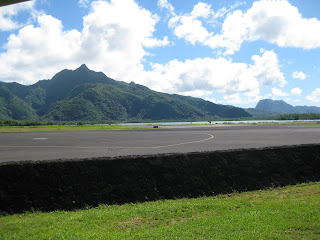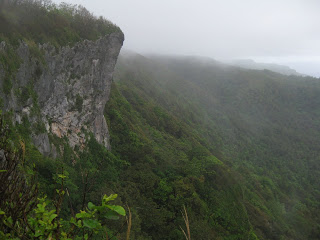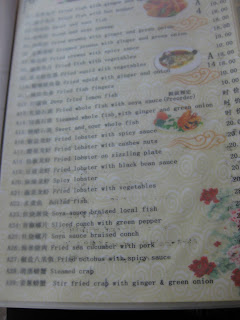Samoa, Part one.
Let us start with a caveat. I understand that I am a tourist. I do acknowledge that the places I go are not there for my entertainment nor should my judgments of them be expected to matter at all to the residents. I am a gringo outsider with all of my personal biases and intellectual baggage coming into someone else's home and telling my stories. I acknowledge and embrace this.
Perhaps you have guessed that I did not unreservedly enjoy my stay in Apia.
The place is pretty. The view below is across the bay towards the governmental complex and main business district. There is a nice, well maintained seawall walk where you can get mugged at night before a truly beautiful backdrop. It is small enough (40,000 population) to walk to most locations, though the Samoans look at you as if you are mad should you try to do so. There are some nice cafes, and a very helpful library. The mountains surrounding the town are gorgeous.
Perhaps I was spoiled by Nuku'Alofa, or I have been on the road too long, or I am just getting soft in my geriatric repose. Apia just wasn't much fun. It felt hostile. The bar district had guys lounging out front staring you down and the aforementioned seawall has hustlers of every stripe, hawking the range from dope to virgins. Women do not walk around alone after dusk. Fights are common, waves and smiles are not. Despite there being more obvious displays of wealth here than in Tonga (though nothing like AmSam) property crime is more common. Or perhaps it is because rather than despite?
In retrospect perhaps Suva was like this too, but I just don't remember getting the same hard vibe. A local bar owner described it to me as the outcome of kids moving away from their very traditional, very hierarchical villages in the back country into Apia, where they have no chief to watch and socially sanction them. Away from the rigidities of their childhood they follow no rules. Whether this is just the local version of 'kids these days' or has a grain of truth I do not know. I do know that I had to watch myself much more carefully here. No late night wanders as throughout Tonga.
Big bummer there, as the night is when I felt most functional. The stars are beautiful here, clear skies and a equatorial locale providing for combinations I had never before seen. The residential neighborhoods were quiet, and human menace was minimal if you avoided downtown. Canine menace was omnipresent. Thousands of dogs run loose and attacks occur frequently. Locals walk with sticks; I quickly learned to wear my boots. In Tonga bending down and acting as if you are picking up a stone would drive away the hounds. Here a bit more direct action is required. The third time I found myself happily booting a dog in the head I gave up. Apia kept its night. I found early bedtimes.
One element was nice. The University has a house on campus where I was allowed to stay for a minimal charge. Three bedrooms, blessedly air conditioned, and with internet. Unfortunately they did not give me the right key to the gate, so several times every evening I found myself hopping this two meter fence.


Continually encountered the Utah link here, as well as in Tonga. Having been raised LDS in Salt Lake I knew Samoan and Tongan kids from childhood. I had not realized how much the flow reversed. There were Utah shops, buses with names like 'Provo' and 'Moab', and graffiti from Utah groups carved into tourist sites. Much of the funding for development projects, and some for commercial enterprises, comes from Utah. You simply cannot escape your childhood. But I shall endeavor to persevere.
Have to admit, the roads are pretty. Not something I say a lot.
Favorite bit of Engrish yet in Polynesia. Karl Rove's apparent brother selling Chinese-made underwear from the "FAT COLLECTION".
Not that all of Apia reminded me of Oakland. Good experiences abounded. The first night there I was recognized by a young Indian gent, dripping with gold jewelry, who had apparently helped me through the application process for a Tongan driver's license. He insisted I come into the roughest bar in Apia, Crabbers, and that he would buy me a beer. Not having anything else better to do I agreed, and was soon in the dance area with about 15 very large Polynesian men who my host, Paul, referred to as his 'boys'. He went on to tell me about his business dealings in Fiji, Tonga, and Samoa, and how I never needed to worry about anything in any of these places as his boys would take care of me. Never really having worried about anything before Apia I was a bit confused, but mildly grateful. Meanwhile the boys were harmonizing along with a locally produced remix of Abba's 'Waterloo' and drinking enormous (750 ml) local Valima beers. Then they all wanted to dance.
Hell, on an average night I would prefer to be in a gay bar than a straight one. They are more fun, more relaxed, and I get sick of the breeder guidos stomping around meat markets. These guys, however, were the massive gay mafia. No one else was even entering the dance floor on a Friday night and aside from Paul the smallest one of the bunch still could play lineman for Oklahoma. I was flattered, and terrified. Slamming back my beer I headed for the door, claiming a prior engagement. A few ass-pats and a phone number later I was sitting out in front of pizza joint down the street when I was hit upon by the first of many fa'afafines to approach me in Samoa. Third gender, very cool, not my thing sexually. But boy, did they like me. Whether it was because of my being a palangi, or my sweat encrusted sexy student t-shirts, I think I met and spoke with half of the 50/50's in Samoa. Probably a good thing, but a bit daunting by #10.
Just an aside (unlike the rest of the blog), how do people actually have sex to some of the music I hear in clubs? I assume that is the point, right? Usher exists to somehow encourage people to have sex with each other, preferably after buying a t-shirt. But dear gods, Abba? I would be laughing too hard to function. Has anyone ever actually got lucky to the strains of 'Waterloo'? Is this why Scandinavia is so sparsely populated?
So that was Friday. Good Friday. Everything then closed at 10PM and the country remained closed until Tuesday. Literally. The whole damn country. I went through my food on Saturday and lasted the rest of the time on peanut butter and Tim Tams. On Easter they showed all six Rocky films in succession on TV. So I went to church instead:
As with the Tongans, the Samoans sing beautifully.
Other great things about Apia? Palolo Deep, some of the best snorkeling I have ever found and a 5 minute walk from downtown. Further confirmation of the over-the-shoulder air conditioning method (Polynesian men frequently walk down the street with one corner of their shirts pulled up and tucked into the collar. Considering the scale of the bellies in some cases, this can be deeply impressive.). Driving in a place where they just switched from the right to the left last September and the cars are a mad mix of left and right hand drives. With arrows pointing both ways still painted on the pavement. And no apparent minimum age for drivers. Decent pizza. The fa'afafines were a bit flighty, but generally interesting to chat with.
The best thing? Hiking up to R.L. Stevenson's grave. Just outside of Apia on a beautiful piece of land he named Valima. He came here to try and recover from TB, ended up dying in Samoa. Highly esteemed by the locals, he still has pride of place in the local mythology. Valima's gardens radiate life.
The hike to the gravesite atop Mt. Vaea should not be as bad as it proved. I have not been swimming in this picture, that is sweat. See my comments above regarding climate. I had no idea my body contained this much moisture.
The view made it all worthwhile.
His epitaph reads:
"Under the wide and starry sky, |
Dig the grave and let me lie. |
Glad did I live, and gladly die, |
And I laid me down with a will. |
This be the verse you grave for me: |
"Here he lies where he longed to be. |
Home is the sailor, home from the sea, |
And the hunter home from the hill." |
That, I can appreciate. Especially right here.

 Next up? Savai'i.
Next up? Savai'i.



























































